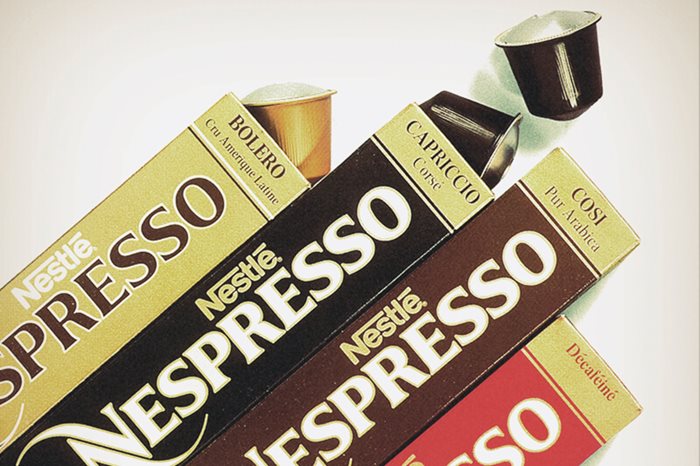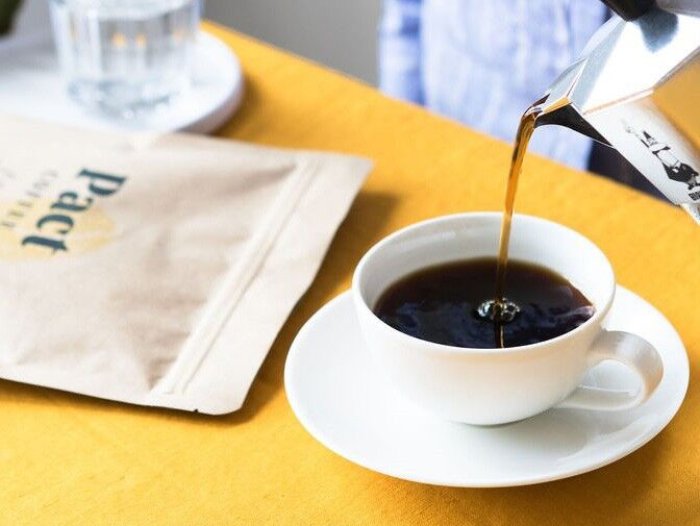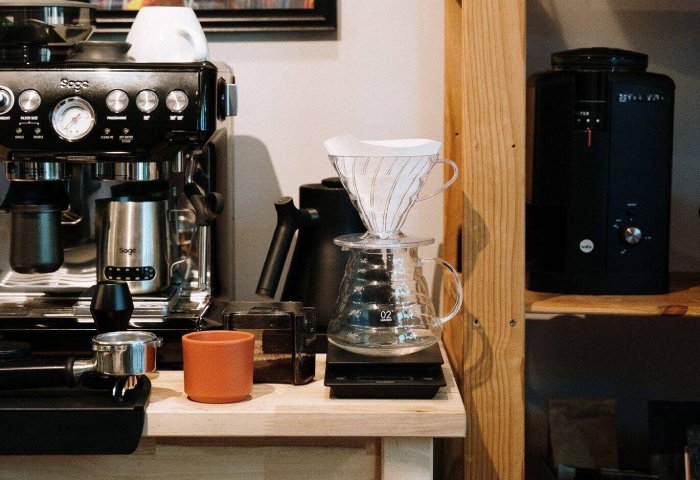Whether brewing with capsules, filter equipment or high-end espresso machines, more consumers than ever before are crafting premium and specialty coffee at home. World Coffee Portal examines what sparked the home barista revolution, how it is developing, and what this new wave of sophistication means for the business of coffee
.jpg.aspx?lang=en-GB&width=700&height=394)
Demand for premium coffee at home has been brewing for decades | Photo credit: Deborah Diem
In our hyper-connected and technologically advanced world, it is entirely possible to run a business from your bedroom, trade stocks in your bathroom or podcast from your kitchen table.
Today, a growing number of consumers are also emulating the specialty café experience at home. Among the estimated two billion cups of coffee consumed every day globally, more than ever are being prepared in the home with premium pods, specialty beans and high-end equipment.
Demand for premium coffee at home has been brewing for decades. Nestlé launched its game-changing Nespresso capsule system back in 1986 and revolutionised espresso consumption in homes, offices and even Michelin star restaurants. More than 14 billion Nespresso pods are sold every year, generating over $7bn in sales annually.
Pod machines represent a quantum leap in quality for instant coffee drinkers, but for many they are also a springboard into the specialty world. Covid opened the floodgates for high-end coffee and home equipment sales, with a growing online eco-system of educational content further propelling specialty coffee to pop-culture status.
World Coffee Portal data estimates the global domestic coffee machine market for pod, filter and espresso units is worth $6.7bn. Today, the fast-developing home coffee market is redefining how roasters, equipment manufacturers and operators do business – and making high-end coffee more accessible than ever before.

The pandemic boom
While Covid lockdowns posed an existential threat for hospitality operators around the world, retail packaged coffee businesses saw sales surge as millions brought their daily coffee rituals home.
In the UK, grocery retailers sold £24m ($30.8m) more coffee and tea in June 2020 than during the same period in 2019 according to market analysts Kantar.
Keeping pace with rising global demand, in July 2020 Nespresso announced it would invest $170.5m adding ten new production lines to its Romont coffee pod facility in Switzerland. The following October, JDE Peet’s announced it would step up coffee pod production by 60%.
Home espresso machine sales also soared. In July 2021 Italian home appliance manufacturer De’Longhi posted what is described as ‘extraordinary’ 319.5% profit growth amid surging demand.
“Lockdowns accelerated growth, but it was always on the horizon”
Jonny England, Director of Coffee, Löfbergs UK & Ireland
“Covid was crazy, everyone wanted a coffee machine,” says Dave Gubbin, President of Sage Appliances EMEA, one of Europe’s leading home appliance and coffee machine manufacturers.
Gubbin says the development of sophisticated automation has pushed the democratisation of making espresso and milk-based beverages at home with ease.
“There are machines that will automatically tamp and calibrate each time you prepare a beverage. The simplicity added to the process means that outside of having to move the handle from the grinding section to the group head and knocking it out, the rest is simple – all the tricky stuff happens behind that.”

Nespresso capsule packaging, 1986 | Photo credit: Nestlé S.A.
The pandemic may have supercharged demand for high-end coffee at home, but a long-term trend towards premiumisation had already primed the market for growth.
“Lockdowns accelerated growth, but it was always on the horizon, and we were already seeing more premiumisation at the retail level,” says Jonny England, Director of Coffee for the UK & Ireland at Löfbergs.
Founded in Sweden in 1906, Löfbergs roasts 34,000 tonnes of coffee per year for the Scandinavian, Baltic, UK and Irish markets with a strong emphasis on sustainable sourcing, renewable packaging and significantly reducing its CO2e emissions.
“You don’t have to go down the rabbit hole to get a great cup of coffee”
Dave Gubbin, President, Sage Appliances EMEA
Demonstrating continued momentum for higher quality coffee at home, England has observed a shift from ground coffee to whole bean in the post-pandemic market.
“Whole bean is massively up and still growing very fast – 14% by volume over the past two years. That shift certainly indicates consumers are more aware about how to make better coffee at home.
“Weʼve also seen lots of great specialty brands launch really great capsule products, but again, since the pandemic that has declined slightly in terms of volume at a retail level,” he says.
Alongside higher quality expectations, growing awareness of sustainability and ethical trade are also factors behind this dynamic. “Both at-home and out-of-home coffee consumers are actively looking for more sustainably sourced products,” says England.
With coffee pods generating an estimated 576,000 tonnes of waste globally every year, even with a growing number of compostable products and collection schemes being launched, it is easy to see why some consumers are going cold on capsules.
As their sophistication grows, budding home coffee enthusiasts are also seeking out new origins, flavour profiles and brewing methods through the thriving specialty coffee subscription market.
Founded in 2012, Pact is a UK-based coffee subscription service and equipment retailer with more than 50,000 regular subscribers. Reaching over one million households in the UK since being founded, Pact adheres to the principles of transparency, traceability, and paying financially sustainable prices to farmers.
“We saw very sustained growth around Covid,” says Will Corby, Director of Coffee and Social Impact at Pact, who adds that coffee sales increased from around 300 tonnes to more than 500 tonnes a year in 2020.
Since then, Corby says overall sales have remained stable but that espresso products are gaining share. “During Covid we saw consumers heavily invest in espresso equipment. With that, there was big shift from standard brew profiles to espresso-based beverages and weʼve seen a continuation of that product mix.”
Knowledge is power
In 2022 there were more than 125 million images and videos with the hashtag ‘coffee’ on Instagram. Inspiring and educational social media content has fanned the flames of the global coffee at home revolution and spurred a new generation of coffee connoisseurs.
UK-based coffee entrepreneur and influencer James Hoffmann has amassed over 1.8 million YouTube subscribers and 400,000 Instagram followers for his product reviews, tutorials and explorations on everything from brewing with a moka pot to roasting coffee in helium.
“The floor of coffee education has risen dramatically over the last five years”
Jon Allen, Creative Director, Onyx Coffee Lab
In the US, Emma Chamberlain has built a $32m packaged and ready-to-drink (RTD) coffee empire anchored by a following of more than 540,000 Instagram followers. Meanwhile, colourful coffee creations such as blueberry pancake cold brew and tiramisu lattes have earned Marissa Gabriel’s The Thrift Witch account a following of more than 415,000 on TikTok.
“High-end specialty coffee has almost become pop culture,” says Jon Allen, Creative Director at Onyx Coffee Lab, a celebrated specialty coffee roaster with five cafés and a training programme based in Arkansas, USA.
“The floor of coffee education has risen dramatically over the last five years and training-wise we’re seeing a lot more adventurous coffee consumers,” adds Allen, who observes greater consumer interest in advanced topics, such as coffee agronomy, fermentation and flavour profiles.
“For coffee brands, pushing further consumer education will be key when it comes to getting the best out of coffee at home, which is probably the biggest challenge holding the market back currently,” says Löfbergs’ England.

Specialty coffee subscriptions are a gateway to higher quality beverages at home for many consumers | Photo credit: Pact Coffee
Bells and whistles
In the US, where Keurig pods and drip coffee makers have long been coffee at home staples, a growing, but still relatively niche, group of consumers is investing in high-end espresso machines and brewing equipment normally the preserve of seasoned baristas.
“Specialty coffee has grown a lot in the US in the past 5-10 years and consumers today are more open to investing in equipment and making a long-term commitment,” says John Holmquist, Commercial and Residential Sales Manager at Seattle Coffee Gear, a professional coffee equipment specialist that is increasingly catering to the domestic market.
Learning to operate professional grade coffee equipment requires time and technical skill, but Holmquist observes that many of his customers have self-taught the basics and are keen to put their skills into practice.
“Consumers are doing more baseline research themselves. They’re looking for precise PID (Proportional Integral Derivative) temperature control and more people are asking for machines with pre-infusion. They might not know exactly what these things do, but theyʼve heard about them through YouTube and online forums and they want to make coffee a hobby.”
Will the bubble burst?
After surging sales during the pandemic, home coffee and equipment coffee sales have slowed over the last 12 months. This can partly be attributed to the reopening of hospitality venues and workplaces, but also subdued demand as households in many markets grapple with the rising cost of living.
In June 2022, German coffee giant Tchibo announced it would be laying off around 300 administrative staff, many of whom were employed on a contract basis to provide extra capacity during the booming Covid years.
“After a significant increase in staff during the pandemic, we will thus return structures to pre-Corona levels,” a Tchibo spokesperson told German media.
Nestlé has also seen lower retail packaged coffee sales over the last year. Nespresso revenues fell 2.2% in the first quarter of 2023 amid what the Swiss food and beverage giant described as a ‘post-pandemic normalisation’ of the category.
Further indicating a slowing of the market, domestic coffee machines sales growth has also tapered off over the last 12 months. In March 2023, De’Longhi reported that falling home coffee machines sales across Europe, the Americas, and MENA region contributed to an 18% decline in first quarter 2023 revenues.
With entry-level home pod or espresso machines typically having a lifespan of around three years, consumers are also likely to retain their current unit before making another significant investment.
World Coffee Portal research corroborates this dynamic in the UK market, showing that total home coffee machines sales rose from £123.2m ($158.2m) in 2019 to £157.2m ($201.8m) in 2022, with the current value estimated at £162.8m ($209m).
However, while sales are projected to rise to 4.1% to reach £169.5m ($217.6m) in 2024, the total number of units sold annually will marginally surpass its 2021 peak of 1.81 million in 2026, when an estimated 1.83 million units will be sold.
In the high-end espresso machine segment, Seattle Coffee Gear’s Holmquist also anticipates flatter sales as many consumers realise complex functionality is often unnecessary for day-to-day home coffee consumption.
“You don't need the craziest equipment to pull a good shot of medium or dark roast coffee. We find folks who buy some of those bleeding edge machines don’t need advanced features and often end up returning machines and getting into things that are a bit simpler,” he says.
“The capacity for specialty coffee shops to continue growing is enormous”
Will Corby, Director of Coffee and Social Impact, Pact Coffee
A tightening of belts during the cost of living crisis could put many consumers’ home barista ambitions on ice.
“Investment in espresso at home is still an exceptionally expensive step for most consumers, many of whom still tend to drink instant coffee. AeroPress and stove top brew methods are very low cost and make excellent coffee,” says Pact’s Corby.
Nevertheless, despite a softening of the home coffee machine market, Sage Appliance’s Gubbin believes significant opportunities lie ahead, particularly in the UK, which has yet to catch up to the more developed European home coffee markets.
“I feel we’ve only just started. The UK is unique because it’s adopted quality coffee quicker, but not in as many households compared to Europe. That’s going to expand massively because every one of those households drink coffee. They may not have got the best cup yet, but as we’ve seen elsewhere, many eventually will.”

A Sage bean-to-cup espresso machine and home barista set-up | Photo credit: Luke Porter
Should coffee shops be concerned?
While coffee operators could justifiably be concerned about growing at-home coffee consumption damaging sales, the evidence suggests specialty cafés can benefit from inspiring consumers to explore new ranges through in-store retail, e-commerce and subscriptions.
“Consumers are more open to investing in equipment and making a long-term commitment”
John Holmquist, Commercial and Residential Sales Manager, Seattle Coffee Gear
Andrew Pautler is founder of the Pull & Pour Coffee blog and online community. Originally a web developer by trade, Pautler went down the specialty coffee rabbit hole and has gained more than 85,000 followers on Instagram for his educational content.
“Having an experience in a coffee shop is a great catalyst and it can be an eye-opening experience with coffee probably much better than anything you would be able to make at home,” he says,
“I love making coffee at home, but it doesn’t mean I don't still love going to cafés,” he adds.
The growing wave of home coffee commerce has had a profound impact on Onyx’s business. Today, Onyx has over 1,000 wholesale accounts, but the majority of its sales are now direct-to-consumer via its e-commerce platform.
“We always had an e-commerce platform, we enjoyed it and it went well, but we never focused a lot of time or energy on it. Covid changed that overnight,” explains Allen.
Pact’s Corby also believes that greater consumer appreciation of specialty coffee will ultimately benefit the majority of operators.
“Even across Greater London, there are many suburbs that don’t have a specialty coffee shop. The capacity for higher-end operators to continue growing is absolutely enormous,” he says.
Is the genie out of the bottle?
For most consumers, making premium coffee in the kitchen doesn’t mean ascending to artisanal greatness, with the majority still favouring the convenience and relatively low cost of pods, stove top pots or filter coffee.
However, in a market where even instant coffee brands are promoting origin and flavour profiles, it is impossible to ignore growing consumer expectations on product quality and choice.
“You don’t have to go down the rabbit hole to get a great cup of coffee. Source the right beans, look after your machine, and you'll have fun with it,” says Sage’s Gubbin.
“We’ve opened up the market, not just to the few people who are in deep, but the many who are going to great cafés all over UK and now able to recreate that at home,” he adds.
Specialty coffee shops and barista skill look set to remain the zenith of coffee creation, providing inspiration for consumers to try new products in-store or online before seeking to recreate them at home.
“I still see there’s lots of headroom for growth in the home market, which is incredibly exciting,” says Löfbergsʼ England.
High inflation and tightened consumer spending have slowed the meteoric trajectory of home coffee and equipment sales seen during the pandemic. However, it is clear consumers value their new-found coffee skills and view quality coffee as an important part of grocery spend.
“Once you start drinking high-quality specialty coffee, it’s very hard to go back,” says Onyx’s Allen.
For roasters to equipment brands, retailers and operators, quality coffee at home is generating huge long-term business opportunities – and educating consumers to expect more from their daily pick-me-up is surely one of the coffee industryʼs greatest achievements.
This article was first published in Issue 15 of 5THWAVE magazine.
Subscribe to 5THWAVE to receive each edition in print and digitally or sign up to our newsletter and be the first to read the latest articles and updates on World Coffee Portal research.
.png.aspx?lang=en-GB)